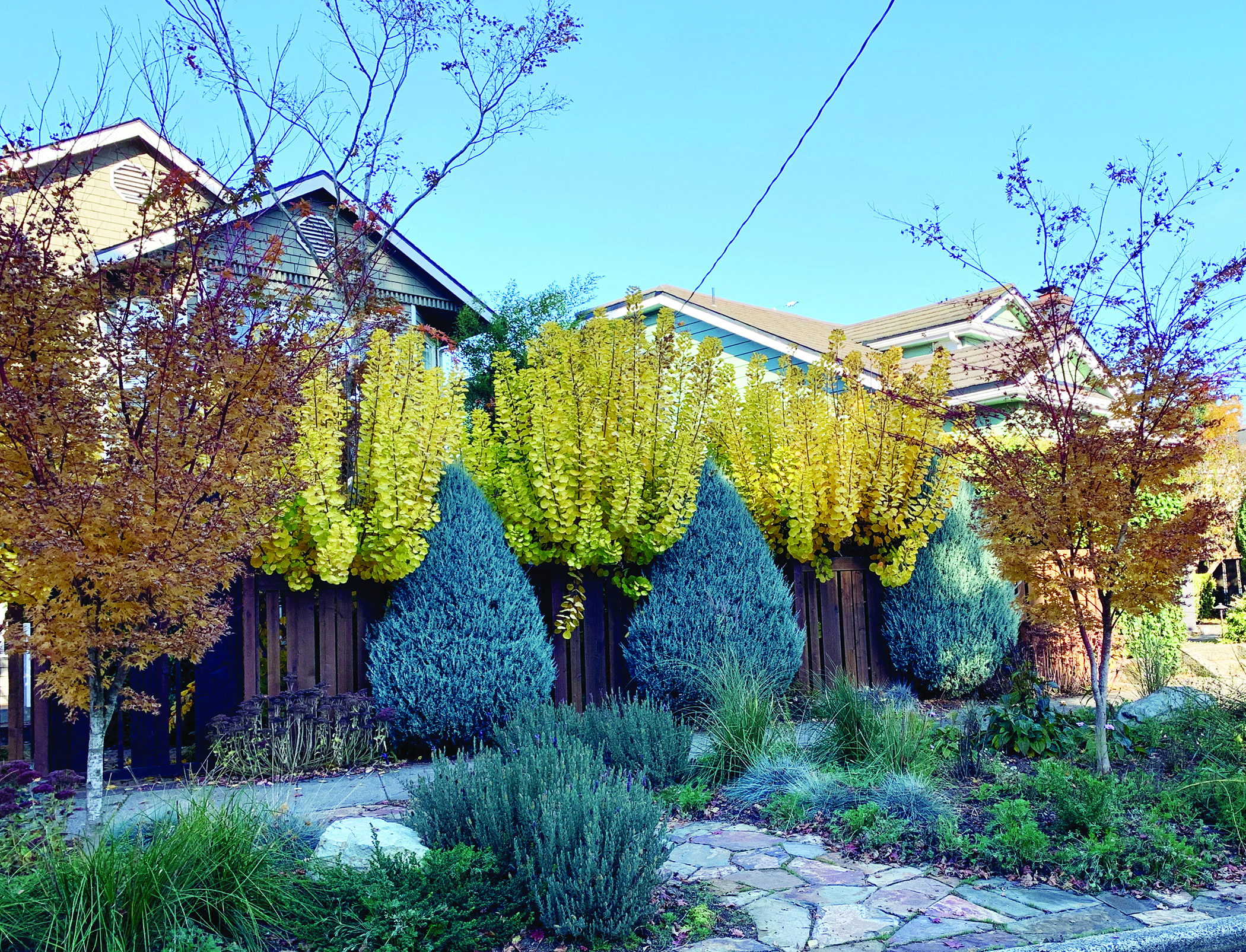An easy way to spruce up a garden for the winter is to find colorful twigs such as yellow- and red-twig dogwood, often sold at nurseries and florists this time of year. Stick them into the ground as they would grow, in a vase shape, wherever you need color or height.
I’m all about efficiency, which is a kinder way of saying I like to avoid extra work, from my hairstyle and clothes to the garden. I adore coming home to a colorful entryway filled with seasonal color but am less excited about overhauling thickly planted containers every four months.
Here are some of my favorite workarounds for sprucing up containers and the landscape this time of year. That’s a funny word, “workarounds”; shouldn’t it be “work-skips”? Either way, it’s about editing away unnecessary effort, which, as the winter holidays approach, is something many can appreciate.
In the garden, if you have already incorporated plants with winter interest liberally in your plantings, you are 90 percent there.
Conifers, plants with lovely bark or winter flowers or berries, or perennials like heuchera that retain their color and leaves, all contribute to the winter landscape. If you have not, you can still create a lush look without digging into frosty ground. A previous column (“Early bloomers and evergreens hasten spring” at queenannenews.com) suggests plants to add excitement in winter and early spring.
Probably the easiest one is to find colorful twigs such as yellow- and red-twig dogwood (shrubby cornus species C. alba and C. sericea), often sold at nurseries and florists this time of year. These are the easiest hack of all — without any care they will look as great in February as they do right now.

Photo by Erica Browne Grivas
A streetside planting is shown, featuring lots of conifers and evergreen shrubs to create winter interest.
It might feel a little silly, but stick them into the ground as they would grow, in a vase shape, wherever you need color or height. In the yard it may take a couple of armfuls to make a real impact. In a container, a handful of three to five should do. Remember to clean these up next spring because in the right conditions they just might root if they were freshly cut.
Another cheat is to lay conifer branches as a blanket or skirt underneath if your garden is lacking evergreen presence. As a bonus, these will act as an insulating mulch if we get an extra dose of frosts. These can also be bought, or you may find fallen branches along wooded trails in places like Discovery, Woodland or Golden Gardens parks. Birch logs and twigs are another popular décor accessory in winter for containers, the landscape or indoors in the fireplace or a vase. Please do not trim trees in the park or your neighbors’ yard (as a certain uncle of mine used to do).
There is still time to plant spring-flowering bulbs through December; if you can find them at nurseries or online, they may be on sale. For optimum sloth, buy potted bulbs in spring — at a higher price.
For container plantings, the same rules apply. I have two main kinds of containers. In the long-standing — read “heavy” — ones, I’ll plant a majority of plants with fun, evergreen foliage and tough constitutions, with one or two seasonal accents. Heucheras, hellebores, sedges and lavender are some favorite permanent elements. This time of year, the accents are small, inexpensive annuals like pansies, violas, ornamental kale.
Let’s take a moment to appreciate violas. They may be tiny, with blooms about the size of your thumbnail, but they are strong! A snow can flatten them, and they’ll burst right back with new flowers when the sun comes out. Many have a delightful, soft, sweet fragrance, and the cornuta types are edible to adorn salads, cakes or ice cubes. (You might want to ask the nursery if those have been grown organically).
They are easy to pop out with a flick of the wrist in four months or so when they are past their prime, when I’ll switch to primroses, fresh pansies or violas, or potted spring bulbs. This happens anywhere from two to three times a year depending on my bandwidth and tolerance for the way the containers look.
The second type of container is an outgrowth of my strong plant collector tendencies. As I fall in love over and over with plants at their seasonal gorgeousness, the number of pots of chrysanthemums, dahlias, ranunculus and more expands. These plants take up space while looking awful or disappearing in the off-season.
The way I’m handling this is to pop them stage left out of sight (literally around a corner or in the side yard between our house and the neighbors’). There will come a time of maximum density when this strategy needs to be, uh, reconsidered, but we’re not quite there yet.
Another way I abet my inner plant collector is by having themed seasonal pots. Not usually a pink person, I fell for a pink ranunculus last year, and then was gifted some potted pink tulips, and voila — the pink pot was born. In summer, I added a pink perennial geum, “Tempo Rose,” which bloomed from June through October in a partially shaded corner of my patio. Thus, I have repositories waiting when impulsive acquisitions occur.
These tips should buy you a little more ease in your winter season and more time to enjoy your friends, family or just putting your feet up under a cozy blanket.